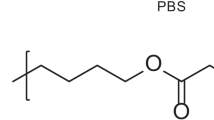Abstract
Poly-L-lactic acid (PLLA) is an optically active, biocompatible and biodegradable polymer that has been widely investigated as an artificial cell scaffold material. In its most crystalline form, PLLA is highly anisotropic and is one of the most piezoelectric polymers known. Conversely, amorphous PLLA exhibits little, if any, piezoelectric behavior. Compression molded PLLA films can be endowed with varying amounts of crystalline character and piezoelectricity by uniaxially stretching the polymer in a hot air bath. Understanding the precise crystalline architecture of PLLA that results from tensile drawing is important for constructing cell scaffolds that have highly tailored biodegradation and cell guiding properties. In our work here, we investigate the changes in the thermal properties of PLLA at draw ratios between 1.0 and 5.5 using differential scanning calorimetry (DSC). The crystallinity of the compression molded undrawn starting material is characterized using X-ray diffraction. Our DSC results show an increase in percent crystallinity with increasing draw up to a draw ratio of 4.0. At greater draw ratios, there is a decrease in the crystalline character exhibited by PLLA.
Similar content being viewed by others
References
H. Tsuji, Biomaterials, 24 (2003) 537.
D. W. Grijpma, H. Altpeter, M. J. Bevis and J. Feijen, Polymer International, 51 (2002) 845.
J. Rak, J. L. Ford, C. Rostron and V. Walters, Pharm. Acta Helv., 60 (1985) 162.
H. Tsuji, Polymer, 43 (2002) 1789.
A. S. P. Lin, T. H. Barrows, S. H. Cartmell and R. E. Guldberg, Biomaterials, 24 (2003) 481.
M. A. Slivka, C. C. Chu and I. A. Adisaputro, J. Biomed. Mater. Res., 36 (1997) 469.
M. Borden, M. Attawia and C. T. Laurencin, J. Biomed. Mater. Res., 61 (2002) 421.
G. G. Giordano, T. C. Thomson, S. L. Ishaug, A. G. Mikos, S. Cumber, C. A. Garcia and D. Lahiri-Munir, J. Biomed. Mater. Res., 34 (1997) 87.
R. Langer and J. P. Vacanti, Science, 260 (1993) 920.
T. Hadlock, S. Singh, J. P. Vacanti and B. J. McLaughlin, Tissue Engineering, 5 (1999) 187.
C. Chen, J. Chueh, H. Tseng, H. Huang and S. Lee, Biomaterials, 24 (2003) 1167.
J. Y. Lim, S. H. Kim, S. Lim and Y. H. Kim, Macromol. Mater. Eng., 288 (2003) 50.
P. Mäkelä, T. Pohjonen, P. Törmälä, T. Waris and N. Ashammakhi, Biomaterials, 23 (2002) 2587.
A. Majola, Annales Chirurgiae et Gynaecologiae, 80 (1991) 274.
H. Tsuji and A. D. Carpio, Biomacromolecules, 4 (2003) 7.
Y. Ikada, K. Jamshidi, H. Tsuji and S. H. Hyon, Macromolecules, 20 (1987) 904.
J. K. Lee, K. H. Lee and B. S. Jin, Eur. Pol. J., 37 (2001) 907.
Y. Maeda, J. Therm. Anal. Cal., 70 (2002) 669.
D. Cohn, H. Younes and G. Marom, Polymer, 28 (1987) 2018.
F. W. Billmeyer, Jr., Textbook of Polymer Science, John Wiley and Sons, New York 1984, p. 482.
T. Ochiai and E. Fukada, Jpn. J. Appl. Phys., 37 (1998) 3374.
E. Fukada, Biorheology, 32 (1995) 593.
Y. Ikada, Y. Shikinami, Y. Hara, M. Tagawa and E. Fukada, J. Biomed. Mat. Res., 30 (1996) 553.
W. J. Landis, Connect. Tissue Res., 34 (1996) 239.
L. E. Alexander, X-ray Diffraction Methods in Polymer Science, Wiley, New York 1969, p. 335.
Gombás, P. Szabó-Révész, M. Kata, G. Regdon Jr. and I. Erös, J. Therm. Anal. Cal., 68 (2002) 503.
D. Cam, S. Hyon and Y. Ikada, Biomaterials, 16 (1995) 833.
E. W. Fischer, H. J. Sterzel and G. Wegner, Kolloid-Z. u. Z. Polymers, 251 (1973) 980.
Author information
Authors and Affiliations
Corresponding author
Rights and permissions
About this article
Cite this article
Turner, J.F., Riga, A., O'Connor, A. et al. Characterization of drawn and undrawn poly-L-lactide films by differential scanning calorimetry. Journal of Thermal Analysis and Calorimetry 75, 257–268 (2004). https://doi.org/10.1023/B:JTAN.0000017347.08469.b1
Issue Date:
DOI: https://doi.org/10.1023/B:JTAN.0000017347.08469.b1




